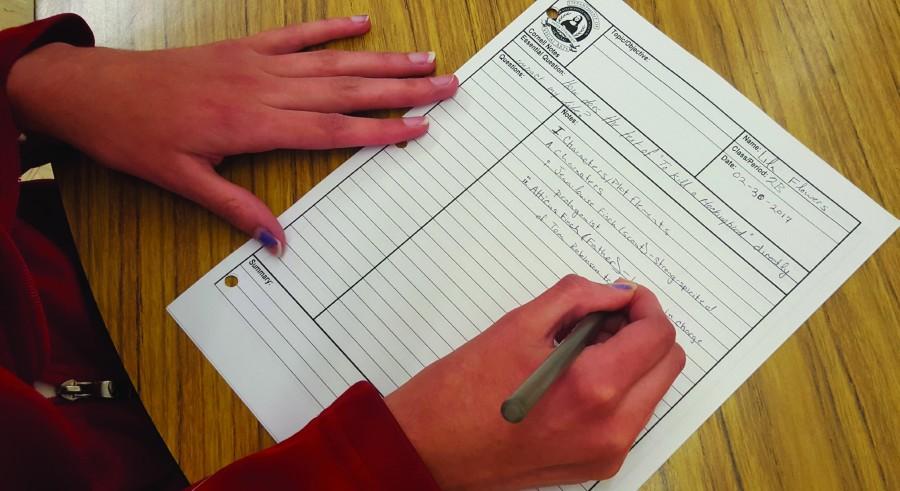Cornell Notes implemented school-wide
Cornell Notes followed a basic two-sided structural outline to facilitate student note-taking and studying.
October 2, 2015
In the 1950s, Cornell Notes were created, to help students comprehend and retain information. According to Ms. Jen Johnson, Taylorsville high school’s AVID coordinator, they came to the school four years ago.
Chemistry teacher Ms. Natalie Paxton, who this year is using Cornell notes for the first time this year, describes the way Cornell notes work. “The first thing is to start with an essential question, so that students know what the goal of the notes are for the day. Then there’s the section where they actually take notes … [and] to the left of their notes, they can go through the notes … and pick out key concepts, and write the questions they might see for those concepts, and … any questions they have concerning it, and then they end with summarizing the notes. This requires them to spend time going back and reviewing their notes, which is the big part of the retention.”
Jesse Curtis, junior, feels that the summary is unnecessary, and of Cornell Notes as a whole, he said, “Most students don’t naturally take notes like that, and when it’s required, the students have to change the way they think in order to take effective Cornell Notes… I’m more of a mental learner, so when I’m forced to write notes, I’m more focused on writing the correct words rather than learning the actual content.”
US History teacher Mr Jake Brown understands how difficult Cornell notes can be for students. “I hated them in high school. I felt it was tedious and useless. But then when I got to college, and started compiling massive amounts of notes every week, I realized that I needed a better system for committing the information to memory.”
And Brown described that system as “engaging your notes within ten minutes, and then engaging them again within twenty four hours and again within seven days. If a student commits to the Cornell Note process, then they will definitely improve the students understanding of the material.”
Paxton provided evidence for their effectiveness. “They have studies that show that when students take notes in a normal fashion, they retain just as much information as if they didn’t take notes, but when using Cornell Notes correctly, they retain significantly more information… so I have high hopes for my students this year.”
Zach Coward, senior, supported Paxton’s evidence by stating that “[Cornell notes] help you with your memory retention for tests and improve scores.”
Many students are frustrated with the extra time required to take Cornell Notes. Taylor Purvis, sophomore, said she hated Cornell Notes because “they’re just time consuming. They’re not really fast.”
Curtis said that Cornell Notes have made it harder for him to learn because “they took too much time to set up and they honestly confused me.”
Coward agrees that Cornell Notes can take a lot of time, but added, “I think the benefits of what [they] give you, … outweigh … having to spend more time on [them].”
Brandon Etherington, junior, agrees that Cornell notes can be helpful, but doesn’t feel that students should be required to use them. He stated that “how people take their notes [should be] their own preference.”
Brown addressed Etherington’s concern, while still defending Cornell Notes, and explained that “There are a million different ways to take cornell notes, so hopefully through the process of learning [them] in different ways from different teachers, students will be able to come to their own conclusions on what works best for them.”





